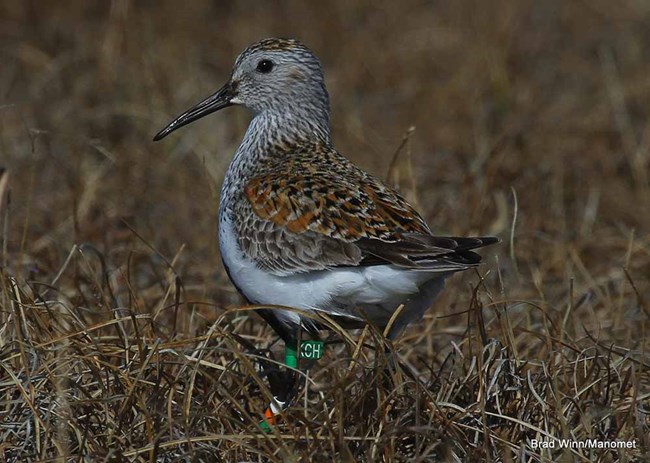Last updated: September 30, 2020
Article
What we learned from 57 years of Dunlin banding

Manomet/Brad Winn
A new study documented migration routes and overwintering areas of Dunlin (a shorebird) that nest in northern and western Alaska, including Cape Krusenstern National Monument. The study was based on 28,000 Dunlin banding records, 747 band resightings, and 71 recaptures of banded birds from 1960 to 2017. Dunlins use the East Asian-Australasian Flyway, which has more threatened and at-risk migratory waterbird species than any other flyway in the world. The breeding range of Dunlins is well known in Alaska, but their migration and winter ranges are more poorly defined. Individual Dunlins tended to return to the same overwintering locations in coastal areas of Japan, the Korean Peninsula, and China year after year. In many of these areas, coastal wetlands have been altered or lost to development, and the populations of Dunlins relying on them have declined. The authors suggest that data provided by this study identifying specific areas needed by Dunlin to successfully migrate and survive over winter can lead to targeted conservation efforts to recover and maintain the species.
Dunlin subspecies exhibit regional segregation and high site fidelity along the East Asian–Australasian Flyway
Abstract
The degree to which individuals migrate among particular breeding, migration, and wintering sites can have important implications for prioritizing conservation efforts. Four subspecies of Dunlin (Calidris alpina) migrate along the East Asian−Australasian Flyway. Each subspecies has a distinct and well-defined breeding range, but their migration and winter ranges are poorly defined or unknown. We assessed the migratory connectivity of 3 of these subspecies by evaluating a dataset that encompasses 57 yr (1960–2017), and comprises more than 28,000 Dunlin banding records and 818 observations (71 recaptures and 747 band resightings). We present some of the first evidence that subspecific segregation likely occurs, with arcticola Dunlin wintering in areas of Japan, and other arcticola, actites, and sakhalina Dunlin wintering in areas of the Yellow and China seas. Observations indicate that whether an arcticola Dunlin winters in Japan or the Yellow and China seas is independent of their breeding location, sex, or age. Furthermore, observations indicate that ≥83% of arcticola Dunlin exhibit interannual site fidelity to specific wintering sites. This suggests that the degradation of specific wetland areas may negatively affect particular individuals of a particular subspecies (or combination of subspecies), and, if widespread, could result in population declines. Given the possible biases inherent in analyzing band recovery data, we recommend additional flyway-wide collaboration and the use of lightweight tracking devices and morphological and genetic assignment techniques to better quantify subspecies’ migratory movements and nonbreeding distributions. This information, when combined, will enable effective conservation efforts for this species across the East Asian−Australasian Flyway.
Lagassé, B. J., R. B. Lanctot, M. Barter, S. Brown, C. Chiang, C. Choi, Y. N. Gerasimov, S. Kendall, J. R. Liebezeit, K. S. Maslovsky, A. I. Matsyna, E. L. Matsyna, D. C. Payer, S. T. Saalfeld, Y. Shigeta, I. M. Tiunov, P. S. Tomkovich, O. P. Valchuk, and M. B. Wunder. 2020. Dunlin subspecies exhibit regional segregation and high site fidelity along the East Asian–Australasian Flyway. The Condor: Ornithological Applications 122: 1-15.
